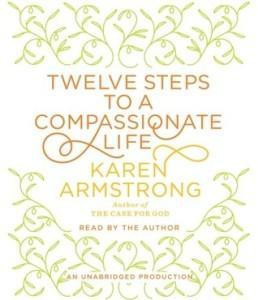 A process for developing personal compassion to engage in compassionate community for a more compassionate world
A process for developing personal compassion to engage in compassionate community for a more compassionate worldWelcome to Compassionate Sunday. We’re working through Twelve Steps to a Compassionate Life by Karen Armstrong, one step per month.
It’s a new month, so we’re starting a new step! April is devoted to The Third Step: Compassion for Yourself. If you’d like to share a post about what you learned about compassion (The First Step) or what you’re seeing in your world (The Second Step) or self-compassion (The Third Step), use the link list below or join the discussion in the comments or on Facebook.
The Third Step of Twelve Steps to a Compassionate Life is “Compassion for Yourself.” I’ve been looking forward to digging into this step because I’ve been lax in my self-care lately and I want to pick up my game a bit here. Here’s the challenge:
…it is not easy to love ourselves. In our target-driven, capitalist Western societies, we are more inclined to castigate ourselves for our shortcomings and become inordinately cast down by any failure to achieve our objectives and potential. (p. 76)
And…
The Golden Rule requires self-knowledge; it asks that we use our own feelings as a guide to our behavior with others. If we treat ourselves harshly, this is the way we are likely to treat other people. So we need to acquire a healthier and more balanced knowledge of our strengths as well as our weaknesses. (p. 77)
The first assignment, as one might expect, is to “make a list of our good qualities, talents, and achievements.” (p. 77)
After that, Armstrong gets into Shadow issues, familiar to anyone who has worked with the philosophy or psychology of Carl Jung. The idea is that if we aren’t aware of our dark sides, our fears and prejudices and perversities, then we’ll attack them in others. She doesn’t mention it, but I’ve done enough Jungian work to know that my anger or disgust can be a helpful mirror for discovering what I’ve let slip into Shadow – if I’m passing judgment on someone else, it’s a signal that it’s time to look at that issue in myself.
At one point, Armstrong reminds us that “Some of our character traits are the result of circumstances beyond our control.” (p. 79) This is a point that is important in the Witnessing Whiteness program that I facilitate. We are scripted by our culture — parents, education, and society. Being aware of the things that we believe that we didn’t choose to believe is the first step to forgiving ourselves and others and to making change.
The final point in this chapter is one that I just don’t get. It’s the Buddhist idea of “no-self” (anatta). How do I have compassion for myself if I claim to have no self? And, how do I achieve that? And, why would I want to? For some reason, when I encounter this idea it always gets tangled up with my Puritan roots and comes at me with a rigidity that I suspect is only in my mind. For the moment, I’m going to let this go and work on the parts of the chapter that I understand. But let me know if you have any insight for me on this issue – I’m sure I’ll circle back around to it at some point.
I was going to design exercises for myself based on the concepts in this chapter, but I discovered a resource when I checked the Reading Group Guide found on the Charter for Compassion’s website. Self-Compassion.org has an assessment test (I did fair to middling on my first pass) and a number of guided meditations and exercises. I’m going to work with those for a couple of weeks and see where that gets me.
What insights do you have about self-compassion?
